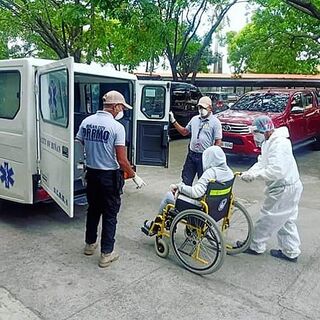Coronavirus Disease 2019
Mental Health Problems for Infected Survivors of COVID-19
Fourth in a series about criticism of mental health research during COVID-19.
Posted December 15, 2020

In my three preceding blog posts, I examined the mismatch between the predictions of a psychological pandemic and the lack of evidence for such in three populations affected by the COVID-19 pandemic: (1) general population of adults, (2) general population of children, and (3) healthcare workers. This post examines a fourth population — infected and symptomatic patients.
One group in Beijing concluded as early as April 2020 that “COVID-19 has also brought a massive impact on public mental health,” and infected patients were an especially vulnerable group (Xiao et al., 2020). Their recommendations included the extraordinary measure of a “global mental health collaborative,” development of new psychological interventions for COVID-19 victims without saying why they needed special interventions, and development of special suicide prevention programs.
What is the research saying?
As noted in earlier posts, there have been many mental health studies published in a rushed fashion with questionable quality. I have looked at five of them which focused on infected patients who survived. More are being published every week.
For anxiety, the average percentage of survivors who scored above validated cutoffs on anxiety measures from 3 studies was 35% (ranging from 24.2% to 42.0%). Without COVID-19, the average in the general population is usually 18.1% (ADAA 2020 10 18).
For depression, the average of survivors who scored above cutoffs on depression measures for 3 studies was 25% (ranging from 22.2% to 31.0%). Without COVID-19, the average in the general population is usually 7.1% (NIMH 2020 10 18a).
For posttraumatic stress disorder (PTSD), the average of survivors who scored above cutoffs on PTSD measures for 4 studies was 39% (ranging from 1.0% to 96.2%). This average is skewed by one study that found 96.2%. Keep in mind that there is no type of trauma — not rape, not burns, not child abuse — where the rates of posttraumatic stress disorder (PTSD) are near 96%. The pre-COVID average in the general population is 6.8% (NIMH 10/18/2020b).
The studies were from China, Ecuador, and Italy.
My estimates are considerably lower than a meta-analysis of 31 studies, which concluded that the rate of anxiety was 47% and the rate of depression was 45% in patients with confirmed COVID-19 infections (Deng, et al., 2020). All but one of those studies were conducted with inpatients.
Overall, if we are to believe these studies, the rate of anxiety disorders has more than doubled, the rate of depression has more than tripled, and the rate of PTSD has increased five-fold.
In my three preceding blog posts, I explained the flaws of these studies. The flaws include (1) Self-administered questionnaires are prone to inflation of symptoms (2) Respondents were self-selected which introduces sampling bias (3) Nearly all of the studies were cross-sectional designs with no causal explanatory power. (4) The few longitudinal studies showed little to no long-term psychological impacts (5) All of the studies I have seen lacked measures of functional impairment (6) Many of these poor-quality studies have been published rapidly with relaxed peer-review by journals, which raises doubts about all of the considerations that go into the conduct and reporting of research.
What it means
Despite these flaws, is there any reason to believe that the results are more believable for patients?
Maybe. PTSD might be a bigger problem for patients compared to other populations. The estimates of PTSD in infected patients are running higher (39% by my estimate) compared to the estimates in the general population (13%) and healthcare workers (31%) (see my posts from November 6 and December 2, 2020). This makes sense. Patients obviously face more direct threats to their lives.
But it is not a slam dunk that rates of PTSD are really higher in patients. There are reasons to be suspicious of self-administered PTSD surveys in non-trauma samples. For years, science journals have been full of examples of artificially inflated rates of PTSD from self-administered surveys. For example, researchers were concerned about PTSD in inhabitants who lived near the area of the Exxon Valdez oil spill in Alaska in 1989. None of these residents incurred injuries. The lives of these residents were never threatened. They were not in any physical danger from the spill. Instead they were stressed because their abilities to make a living were harmed because the oil spill damaged their fishing grounds. Researchers made the unlikely conclusion that PTSD was present in 25% of the residents around the spill.
Another example comes from researchers in England who were concerned about the impact from the stress of divorce on children. They surveyed adolescents and made the unlikely conclusion that 34% of them qualified for divorce-related PTSD. PTSD supposedly followed at a higher rate from divorce than from other truly life-threatening experiences in that study!
Most of the individuals who supposedly had PTSD in those studies did not have PTSD for a variety of reasons, including that surveys do not adequately distinguish between truly life-threatening events and stressful but not life-threatening events, survey questions do not adequately convey that symptoms need to be excessive to be counted as symptoms as opposed to normal reactions, and many PTSD symptoms are abstract, complicated, and easily misunderstood without an interviewer to explain them. For more details, I’ve written previously about what counts as a traumatic event (June 7, 2017).
In addition, the criterion of being life-threatening alone is not usually sufficient to cause PTSD. The types of events that tend to cause PTSD usually need to be sudden and unexpected so that they create a moment of intense panic for one’s life. Specifically, being symptomatic and hospitalized would not typically cause PTSD if the symptoms arose gradually and were managed effectively.
However, if symptoms increased suddenly, unexpectedly, and it felt like the situation was getting out of control rapidly, this would be more likely to cause PTSD. That would certainly apply to many patients with COVID-19 infections. We really do not know how many are in that category and truly developed PTSD until we have better research with trained interviewers who know how to ask about PTSD.
References
ADAA (10/18/2020), Anxiety and Depression Association of America. Facts & Statistics. https://adaa.org/about-adaa/press-room/facts-statistics. Accessed 10/18/20.
Deng J, Zhou F, Hou W, Silver Z, Wong CY, Chang O, Huang E, and Zuo QK (2020). The prevalence of depression, anxiety, and sleep disturbances in COVID-19 patients: a meta-analysis. Annals of the New York Academy of Sciences, 1-22 (published online 10/2/20), doi: 10.1111/nyas.14506.
NIMH 10/18/2020a. Major Depression.
https://www.nimh.nih.gov/health/statistics/major-depression.shtml. Accessed 10/18/20.
NIMH 10/18/2020b. Posttraumatic Stress Disorder (PTSD). https://www.nimh.nih.gov/health/statistics/post-traumatic-stress-disord…. Accessed 10/18/20.
Xiao C, Wang G (2020). Letter to the editor: Mental health work in the context of the COVID-19 pandemic: What progress have we made so far and what is the next step? Journal of Psychiatric Research 129:122-123, https://doi.org/10.1016/j.jpsychires.2020.05.023




